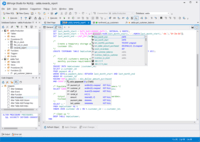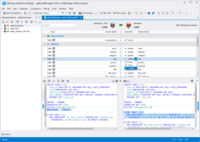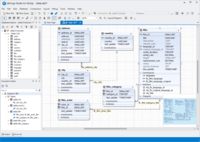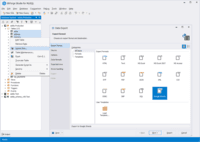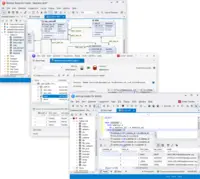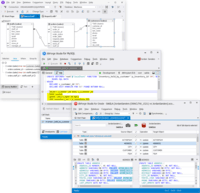Overview
What is dbForge Studio (Edge)?
dbForge Studio is provided by Devart and is a universal front-end client for database management, administration and development. Devart's GUI tool provides utilities to compare, synchronize, and back up databases (e.g. MySQL, Oracle, SQL Server, PostgreSQL, etc.) with scheduling, and includes the possibility to…
The Tool of Choice for DBAs and Developers
A good workmate to develop on SQL server
Good experience with dbForge Studio for MySQL
Best MySQL management tool I've ever used
dbForge Studio for MySQL creates a nice warm hearth for database management and automation
The best platform for managing SQL Server databases
Quick Database Comparisons
dbForge Data Compare is a great tool for managing and syncing databases in multiple environments
Refreshingly easy to use tool!
Best SQL Server IDE for Really Effective Development
Once you try it, there is no going back
You need monitor your SQL server with dbForge Studio
dbForge is one of the best MySQL db clients for windows, but there is still room for improvements
dbForge Studio for MySQL made a huge difference in our processes.
dbForge Studio for MySQL does the job
Pricing
Standard (subcription)
$9.95
Professional (subscription)
$19.95
Enterprise (subscription)
$29.95
Entry-level set up fee?
- No setup fee
Offerings
- Free Trial
- Free/Freemium Version
- Premium Consulting/Integration Services
Product Details
- About
- Competitors
- Tech Details
What is dbForge Studio (Edge)?
dbForge Studio (Edge) Features
Database Development Features
- Supported: Version control tools
- Supported: Test data generation
- Supported: Performance optimization tools
- Supported: Schema maintenance
- Supported: Database change management
Database Administration Features
- Supported: User management
- Supported: Database security
- Supported: Database status reporting
- Supported: Change management
Additional Features
- Supported: Data Comparison and Sync
- Supported: Data Editor
- Supported: Administration and Maintenance
- Supported: Database Backup and Restore
- Supported: Database Refactoring
- Supported: Debugger
- Supported: Exporting and Importing Data
- Supported: Object Editors
- Supported: Query Builder
- Supported: Data generator
- Supported: Documenter
- Supported: Copy database
dbForge Studio (Edge) Screenshots
dbForge Studio (Edge) Competitors
dbForge Studio (Edge) Technical Details
| Deployment Types | On-premise |
|---|---|
| Operating Systems | Windows, Linux, Mac |
| Mobile Application | No |
| Supported Languages | English |
Comparisons
Compare with
Reviews and Ratings
(51)Community Insights
- Business Problems Solved
- Pros
- Cons
- Recommendations
dbForge Studio for MySQL has received praise from users and reviewers for its wide range of use cases and valuable features. Users have found it to be an essential tool for interacting with MariaDB and MySQL databases, particularly in comparing data between databases or tables. The software's ability to import and export data in various formats, such as CSV, Excel, and Word, has been commended for its convenience in working with different file types. Additionally, the database tools in dbForge Studio for MySQL have been highly appreciated for their session and security checks, enabling users to effectively monitor and maintain their databases' integrity.
The SQL query completion and error analysis feature has proven to be a valuable asset for developers, enhancing productivity by providing real-time suggestions and identifying errors. The creation of views and other objects with visuals and wizards simplifies the process of creating and modifying stored procedures. Users have praised dbForge Studio for MySQL's reporting and visualization capabilities, although some have not fully explored these features yet.
Furthermore, the software has been instrumental in facilitating database version upgrades and platform migrations, ensuring smooth transitions between database versions and platforms. Its code completion and suggestion functionalities have garnered commendation for their accuracy and effectiveness in expediting IT staff's database tasks. Notably, during an Oracle Utilities Suite upgrade implementation, users have found the tool crucial in identifying DDL, index, partitioning, PK, and constraint errors, allowing them to promptly address discrepancies.
In various industries like transport management software development and agriculture, dbForge Studio for MySQL has played a significant role in improving productivity through features like code completion, easy debugging, database design capabilities, query writing, generating meaningful test data, and more. The software has proven valuable across organizations in optimizing workflows and addressing database administration challenges.
For specific use cases like updating parts prices in a MySQL database for a company dealing with vintage Mustangs and selling parts, dbForge Studio for MySQL stands out with its user-friendly interface and efficient functionality. The ability to take backups of the entire database and restore them as needed has been widely appreciated by users.
Additionally, dbForge Studio for SQL Server has been lauded for its user-friendly experience compared to SQL Management Studio, empowering users to be more productive in SQL Server management and development tasks. Its features, including database documentation, schema and data comparison, unit testing, code formatting, source control, database design, index management, data generation, search, monitoring, backup and restore, debugging, query profiling, and IntelliSense have been well-implemented and eliminating the need for additional tools and providing benefits in schema comparison and deployment, code completion, intelligent IntelliSense, and code suggestions. Likewise, dbForge Studio for PostgreSQL has gained recognition as a suitable replacement for SQL Management Studio, particularly for data querying and editing tasks. Its well-organized user interface and useful features like grouping and sorting data directly in the data grids have been appreciated by users.
The versatility of dbForge Studio for MySQL extends to its usage in syncing data between pre-production environments, troubleshooting differences in data, and generating update scripts for syncing other environments with the help of dbForge Data Compare for MySQL. Users have found this tool valuable in maintaining consistency across various stages of software development.
Technical support for dbForge Studio products has received commendations, with prompt bug fixes reported even before becoming customers. Additionally, the ability for users to publicly request new features that are implemented if voted on by other users demonstrates a responsive approach to meeting user needs.
Across different domains such as query management and editing, designing databases, writing SQL code, monitoring running SQLs, administrative tasks, and data management for HR departments, dbForge Studio products have proven to be reliable and efficient tools. Users appreciate the intuitive interfaces, SSH connection capability, gibberish data generator, and automation of repetitive tasks in dbForge Studio for SQL Server.
In summary, dbForge Studio products have been valued by users as critical tools for interacting with databases like MariaDB, MySQL, SQL Server, and Oracle. The software offers a wide range of features including data comparison and synchronization, code completion and analysis, visualization capabilities, version control support, backup and restore functionality, database design tools, as well as excellent technical support. It addresses various needs across industries such as software development, database administration, query management, and more.
Useful Import and Export Wizards: Many users have found the Import and Export wizards in the tool to be very useful, with a lot of options and a handy wizard. Several reviewers appreciate the ability to import data to tables that other import tools struggle with.
Effective Data Comparison Tools: The tool's ability to compare data between tables or databases is highly praised by users. It has been described as great for identifying discrepancies, inconsistencies, and changes between source and target environments. Some users also value the schema comparison tool, which is useful for upgrades or syncing up databases.
Intuitive Create View/Edit View Tool: Users find the create view/edit view tool intuitive and easy to use. They appreciate being able to drag and drop from any table, perform functions on any field, and visually see all joins, grouping, and other criteria. This feature doesn't compromise functionality while making the process easy for users.
Inconsistent SQL conversion: Some users have mentioned that the conversion from SQL to the visual tool in dbForge Studio is not always clean, leading to inconsistencies and errors in the view's logic.
Limited customization of output reports: Several users have expressed dissatisfaction with the plain and minimalistic output reports generated by dbForge Studio. They believe that these reports lack detail and structure, suggesting that they could be improved with more comprehensive information and a pivot table-like format.
Lack of database analytics windows: A number of users have pointed out the absence of database analytics windows in dbForge Studio. They feel that this hampers their ability to gather insights into currently running queries and obtain better statistics about their MySQL servers.
Users commonly recommend dbForge Studio for MySQL for the following reasons:
- The software is highly praised for its professional support, reliability, and feature set. Users appreciate the level of assistance provided by the developers and find the software to be stable and trustworthy.
- Many users suggest trying out the trial version of dbForge Studio for MySQL before purchasing the licensed version. They mention that it doesn't take long to realize the need for the full version due to its comprehensive features and efficiency compared to other free tools.
- Transitioning from other database management tools, such as SQL Server Management Studio or MS Access, to dbForge Studio for MySQL is often recommended as a smooth process that allows users to start producing results immediately. They find the interface intuitive and emphasize the ease of use. It's important to note that these recommendations are based on user experiences and opinions, which may vary depending on individual needs and preferences.
Attribute Ratings
Reviews
(1-5 of 5)dbForge Studio for MySQL creates a nice warm hearth for database management and automation
- A detailed wizard to compare data between databases or tables.
- Importing and exporting data in many formats from csv's to Excel, Word, and just about anything else.
- Database tools to check Sessions and Security.
- SQL Query completion and error analysis.
- Creation of Views and other objects with visuals and wizards.
- Reporting and other great visuals that we just have not gotten around to yet.
- Import and Export wizards from and to many different sources with a lot of options and a very handy wizard. I am able to import data to tables that other import tools choke on. The wizard is able to export or import to 15 different options.
- It can compare data between tables or databases, which is great as it is, but it also has a schema comparison tool. It makes an all around set of tools useful for upgrades or syncing up databases.
- The create view/edit view tool makes that process as easy as dragging and dropping without losing functionality. You can drag from any tables, perform functions on any field, and visually see all of your joins, grouping, and other criteria both visually and in generated SQL.
- The database explorer is really nice as it allows grouping, and coloring databases based the type of environment.
- I could keep going, but I'll end with the command-line generation, which allows the creation of a snippet of script code that automates the tool. We have some repetitive tasks that are completely executed at the command-line via a script.
- The import wizard is really good, but I would like to have a direct import from a SQL Statement.
- The Create View or Modify View function generates the SQL, and you can edit the SQL directly. This is really handy, but directly editing the SQL sometimes produces errors in the view's logic. The conversion from SQL to the visual tool is not always clean.
- In the database explorer, I like to keep all of my database connections all neat and orderly in there, which works great with color coding, but it would be a nice to have non-connection objects to create spacing and other organizational functions.
- Positive impact on reducing need for additional staff and ability for staff to perform DBA tasks on their own. I would say approx. 20% savings.
- Automation of critical tasks like various data exports/imports. ROI was greater there, nearly 70% since it eliminates entire tasks.
- Positive impact on an objective to enabling remote management in one tool for our database management.
- We wanted to make database management easier, and the tool makes it about 30% easier. The tasks still require specific knowledge, but it's a good start.
Quick Database Comparisons
- Quick, high-level comparison of thousands of tables and their details
- Intuitive identification of findings, such as discrepancies, inconsistencies, things that are equal, and source/target environment changes
- The ability to parameterize searches more would be advantageous. For example, being able to specify to only look for certain columns, certain data type changes, etc.
- The output reports from dbForge are very plain and could contain more detail, and perhaps be structured more like a pivot table form Excel
Whenever a user or DBA wants to compare schematics between two environments, dbForge is extremely helpful. This is useful during version or framework upgrades, a database upgrade, patch implementations, service package implementations, or any time to environments would be different.
The time it would take to write and execute queries, and then compare is exponentially longer than it takes with dbForge, where this is done and you have an application that allows you to quickly identify incongruities.
- Time saved is hard to measure, but perhaps weeks of cumulative analysis has been saved by having the application able to quickly compare schematics and data.
- Removing estimations and assumptions around deployed environments is also hard to measure. For example, instead of deploying a new patch, and trusting that high-level queries based on previous exercises will catch discrepancies, dbForge is able to examine all tables, views, indexes, jave components, triggers, and really any other common database object.
Although we had to pay licensing fees to use dbForge, one of the main reasons we chose dbForge is compliance-related: we did not want to use freeware to analyze our database, since we are a utility company that has personally identifiable information in our databases.
Additionally, dbForge had additional features that DBeaver did not, and a smoother application interface for non-DBA expert users to navigate.
Refreshingly easy to use tool!
They do not currently have the ability to graphically design or edit table/database schemas, which makes this tool a no-go for most development tasks (unless you are just writing functions/stored procs, and then the intellisense is very handy). However, the grouping and sorting of data right through the data grids is extremely useful. Grouping is also a snap by a simple right-click on any column. You can even edit data from a query instead of having to edit all the data in the table!
- Intellisense is rock solid.
- Sorting, filtering, and grouping are super easy by just using the grid columns. No having to write queries!
- UI is super intuitive.
- There is a master-child detail designer where you drop tables into the designer, link up their relationships (whether there are foreign keys or not), and then you can view the linked data.
- No table/database designers (yet). They have said it's coming.
- No way to create scripts to create the database/tables that other tools have. This makes it difficult for developers to use to generate DDL scripts.
- Data export does an individual insert per row of data, which is a little inefficient. Other tools will do a single insert for a configurable amount of rows per insert statement.
- Saved a TON of time when looking at massive amounts of parent/child data by allowing us to just use the master-detail browser.
- Very little training time needed for employees that are already used to using SQL Management Studio. This is a proper Windows UI application.
- Very cost effective to purchase the standard edition for every employee that needs it, but the free edition does most of what they need too!
Valentina was just way too hard for people to navigate and use on a daily basis.
dbForge is one of the best MySQL db clients for windows, but there is still room for improvements
- Connection manager (we use it through ssh tunnels) works effortlessly.
- Great sync tools for both database schemas and data.
- Storing code snippets to be used when needed.
- Nice code suggestions while typing queries.
- Usually does very well with storing your session and opening all of your sql tabs when opening the apps next time.
- Does very well when executing large sql files (without opening the files into the application that is).
- Pretty good debugging help when a problem occurs in executing a query or a files with multiple queries.
- We have about 10 different server connections open at the same time to manage database on each of those servers. Unfortunately this breaks the very useful typing-suggestions of dbForge, as it no longer seems to understand where to look for the right tables and columns. The query does execute correctly though.
- I wish there was an easy way to store a standard configuration when doing a backup for databases. There is a couple of tables which we never backup, and every time I have to uncheck those tables manually before doing a backup.
- The JSON viewer is great, but is also unfortunately lacking in a couple of ways:
- 1- No folding/unfolding of blocks
- 2- Depending on the position of the data cell in your screen, the JSON viewer window can be displayed at an uncomfortable position and size, without an option to correct this, making reading the data very hard
- 3- The search and find function for data in cells is very contra-intuitive: when I open a cell t view it's data, I do not expect the search and find function to hop to other cells. This causes me to loose my current view and having to find and load the cell I was in all over again.
- This only happens rarely, but when it happens it is very frustrating: the backup or restore function freezes somewhere in the middle of the process without any error or warning message. But as said, this only happens very rarely.
- I wish I could execute a file on multiple databases at once. At the moment I have to manually select each of the database where I would like to perform an update on before executing the update SQL.
- Selecting rows of data and copying them into a table (with an equal number of columns and appropriate column definitions) as an update for existing rows sometimes gives unreasonable errors.
- When editing the structure of a table, it is not possible to copy multiple column definitions to another table, or even just select a couple of columns and dragging them into a different position for the same table.
- I have seen some very nice database analytics windows in other mysql clients like Querious and even Workbench. I really miss better statistics about running mysql servers + insight into currently running (slow) queries. I know this all available info, so it is unfortunate that I have to write queries and dig into the server myself to find this kind of info.
- The look and feel really could be improved into a more modern and minimalistic application. Once again, look at Querious for inspiration.
- We perform better and faster syncing analysis between databases.
- We update running mysql databases faster and more efficiently.
- Especially with MySQL Workbench we had immense irritations due to all the crashes during the day. With dbForge Studio we finally had a power tool which is stable and does not crash constantly.
- Much more stable than MySQL WorkBench
- Has the power tools a db designer wishes for but lacks in free clients like HeidiSQL
- Is being improved regularly
- Is fairly well supported
dbForge Studio for MySQL does the job
- The user interface is well thought out and well organized, and that makes dbForge Studio for MySQL a pleasure to use.
- dbForge Studio for MySQL is exceedingly stable - I've never had a problem with it crashing or locking up; nor have I come across any bugs in it.
- It's easy to make backups in dbForge Studio for MySQL, which encourages frequent backing up of schema and other important data.
- I use dbForge Studio for MySQL in a limited environment - an online store hosted by Bigcommerce - so I don't see anything that cries out for improvement. It might be different if I was juggling multiple databases in an enterprise environment spread out over the Internet, but for what I need, dbForge Studio for MySQL does the job perfectly.
- dbForge Studio for MySQL has allowed me to save my clients money because it saves me time. It enhances my reputation for reliability because it allows me to respond to my clients' needs in a timely manner by performing database updates quickly.
1) For the most part I don't like Microsoft products. Their UIs are notoriously bad, and you never know when a product tweak will create incompatibilities that will require an expensive upgrade.
2) Since our online store host uses a MySQL database, I need a tool that's designed to work with MySQL.
3) When evaluating SQL tools, dbForge impressed me with its ease of use.

